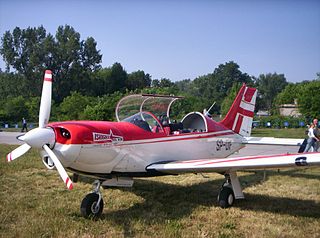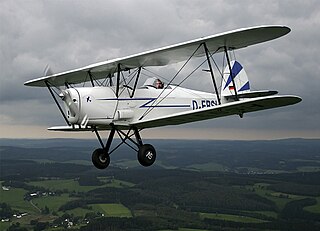Related Research Articles

The Sequoia Falco is an Italian-designed lightweight 2-seater aerobatic aircraft.

The Pitts Special is a series of light aerobatic biplanes designed by Curtis Pitts. It has accumulated many competition wins since its first flight in 1944. The Pitts biplanes dominated world aerobatic competition in the 1960s and 1970s and, even today, remain potent competition aircraft in the lower categories.

The RyanNavion is a single-engine, unpressurized, retractable gear, four-seat aircraft originally designed and built by North American Aviation in the 1940s. It was later built by Ryan Aeronautical Company and the Tubular Steel Corporation (TUSCO). The Navion was envisioned as an aircraft that would perfectly match the expected postwar boom in civilian aviation, since it was designed along the general lines of, and by the same company which produced the North American P-51 Mustang.

PZL M26 Iskierka or M26 Airwolf is a Polish trainer and aerobatic aircraft, designed at WSK PZL-Mielec.

The Stampe et Vertongen SV.4 is a Belgian two-seat trainer/tourer biplane designed and built by Stampe et Vertongen. The aircraft was also built under licence in France and French Algeria.

The Christen Eagle, which later became the Aviat Eagle in the mid-1990s, is an aerobatic sporting biplane aircraft that has been produced in the United States since the late 1970s.

The Great Lakes Sport Trainer is an American biplane trainer and aerobatic aircraft. It was originally produced in large numbers before the company building it went bankrupt in the Great Depression in 1933. Owing to its continuing popularity, however, it was eventually placed back into production in the 1970s and again in 2011 by WACO Classic Aircraft.

The MX2 is a carbon fiber, two seat tandem sport aircraft produced by MX Aircraft of Perth, Western Australia. The MX2 has been used by competitors in the annual Red Bull Air Race World Championship.

The Payne Knight Twister is a single-seat, single-engine aerobatic sport aircraft first flown by Vernon Payne Sr. in the United States in 1932 and marketed in plans form for homebuilding.

The Steen Skybolt is an American homebuilt aerobatic biplane. Designed by teacher Lamar Steen as a high school engineering project, the prototype first flew in October 1970.

The Smith DSA-1 Miniplane is a single-seat, single-engine sport aircraft designed in the United States in the 1950s and marketed for home building.

The Stolp Starduster Too SA300 is a two-seat, conventional landing gear equipped homebuilt biplane. Aircraft Spruce & Specialty Co currently holds rights to sell plans for the aircraft.

The Dyn'Aéro CR.100 is a French kit built single engine, two-seat monoplane, developed in the 1990s and intended as both an aerobatic trainer and a tourer, primarily for aero club use.

The Borgward BFK-1 Kolibri, aka Borgward-Focke BFK-1 Kolibri, was a German three-seated utility helicopter built by Borgward, designed by Heinrich Focke and was the first German helicopter after World War II. The helicopter first flew on July 8, 1958, in Bremen, piloted by Ewald Rohlfs.

The Stolp-Adams SA-100 Starduster is a U.S. single seat sport biplane designed to be built from plans supplied by Aircraft Spruce & Specialty Co. Though the first flight was in 1957, Stardusters continue to be built and flown.

The Ultimate Aircraft 10 Dash is a Canadian single-seat sport and aerobatic biplane designed and built by Ultimate Aircraft Corporation of Guelph, Ontario.
The Shirlen Big Cootie is an American homebuilt biplane that was designed by Roy Shirlen.

The SkyDancer SD-260 was an American aerobatic homebuilt biplane that was designed and produced by SkyDancer Aviation of Louisville, Kentucky, introduced in the mid-1990s. When it was available the aircraft was supplied as a kit.
The Starfire Firebolt, sometimes called the Starfire Firebolt Convertible, due to its removable canopy, is an American homebuilt aerobatic biplane that was designed by G. H. "Mac" McKenzie and produced by Starfire Aviation of Tempe, Arizona. When it was available the aircraft was supplied in the form of plans for amateur construction, with some pre-fabricated parts available.
The Ultimate 10-200 is a Canadian homebuilt aerobatic biplane that was designed produced by Streamline Welding of Hamilton, Ontario, introduced in the 1990s. When it was available the aircraft was supplied as a kit or in the form of plans for amateur construction.
References
- Notes
- ↑ "Blood Sweat and Tears". Sport Aviation: 19. January 1966.
- Sources
- Taylor, Michael J. H. (1989). Jane's Encyclopedia of Aviation. London: Studio Editions. p. 297.
- Jane's All the World's Aircraft 1977-78. London: Jane's Yearbooks. pp. 533–34.
- Jane's All the World's Aircraft 1985-86. London: Jane's Yearbooks. p. 587.